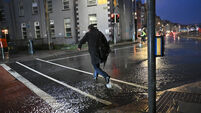US housing is 25% less than in Ireland
The US is in the midst of housing boom and prices have rocketed by 9.8% this year the largest year-on-year rise in the country since 1987.
In Ireland we don’t do things by half any more, our housing boom is bigger.
The average price of a home in Ireland has by a number of measures slipped passed the €200,000 barrier earlier this year while in the US the average home costs a mere $160,000 with 5.77 million homes sold in the US in a year and yesterday’s figures showing a 6% increase in home sales.
The €200,000 plus price tag was confirmed yesterday in the latest edition of the permanent tsb House Price Index, compiled in association with the ESRI, which shows the average price of a house in Ireland is now €200,606.
This is an increase of a massive 167% since 1996 when the index was started and the average house cost €75,169.
No one can say when the Irish house price and building boom will end. We are building 55,000 houses a year, one for every 70 people in the state compared to Britain where a new house is being build for every 350 people.
Yet demand is driving prices higher as not enough houses are being built in the Dublin area where people want them.
Economic consultants DKM’s construction expert Annette Hughes reckons just 12,000 houses are being built in the Dublin area where she estimates there is a demand for close to 20,000 houses a year.
Ms Hughes says the shortage of new houses in Dublin is sending prices higher and this is where the real log jam is.
The house price boom can’t continue but no one wants the bubble to burst either, as the impact of thousands of householders in a negative equity situation would cause a real headache in a small economy.
The ideal is for house price inflation to match general inflation or wage inflation but not leap ahead any further.
Ms Hughes said there does appear to be some softening in the main drivers in the market.
Employment growth is slowing which will ease the demand for houses, repatriation of Irish workers is on the wane and may even reverse as the Irish labour market gets tighter especially in specialist high skill areas.
A year ago house prices were actually falling or flat. The loosening of tax relief on investors saw them pour into the market. This happened just as first time buyers were beginning to take the plunge in larger numbers, after hesitating on the sidelines for months. This exacerbated the demand for new houses to the delight of builders as house prices rose yet again.
And house buyers are now faced with a dilemma should they opt for fix rate interest rates on the cusp of a possible 0.5% cut in interest rates by the European Central Bank.
Bank of Ireland’s economic research unit summarised the problem in their November bulletin when they said the best time to fix was at the bottom of the cycle but said the problem in trying to determine the bottom of the cycle was that it can only be identified after it has past.
“It follows then that the best time to fix is just before the market decides that the cycle is turning which may mean fixing at a time when variable rates are still falling, a difficult decision for some.”














